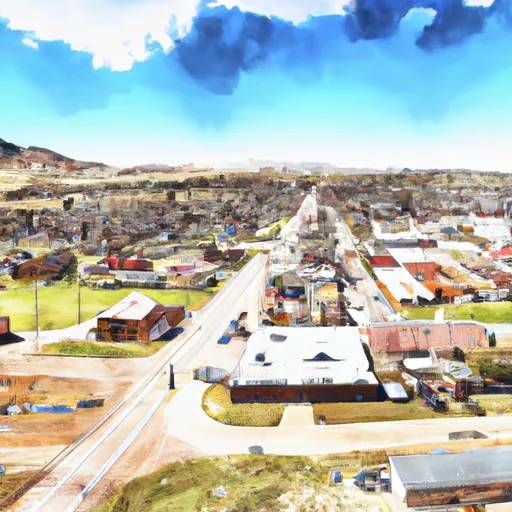-
 Snoflo Premium
Snoflo Premium
Get unlimited access to all our content
With no Ad interruptions! - Start Your Free Trial Login with existing account
Utleyville
Eden Index
Climate
9.3
•
Recreation
•
Community
•
Safeguard
3.7/10

Utleyville, Colorado is a small, unincorporated community located in Otero County. Situated in the southeastern part of the state, Utleyville experiences a semi-arid climate. Summers are warm with average temperatures ranging from the mid-80s to low 90s Fahrenheit, while winters are cold with temperatures often dropping below freezing. The area receives around 12 inches of precipitation annually, with most of it occurring during the summer months. Utleyville also experiences occasional thunderstorms and high winds.
As for hydrology constituents, Utleyville is not near any major rivers or lakes. However, the community is surrounded by several small creeks and irrigation ditches that contribute to the local water supply.
Utleyville and its surrounding area offer numerous outdoor recreation opportunities. The nearby Comanche National Grassland provides opportunities for hiking, camping, wildlife viewing, and bird watching. Outdoor enthusiasts can also enjoy fishing in the nearby lakes and reservoirs, such as Lake Cheraw and Queens Reservoir. Additionally, the region's vast open spaces make it ideal for activities like horseback riding, off-roading, and stargazing.
What is the Eden Index?
The Snoflo Eden Index serves as a comprehensive rating system for regions, evaluating their desirability through a holistic assessment of climate health, outdoor recreation opportunities, and natural disaster risk, acknowledging the profound impact of these factors on livability and well-being.
Climate Health Indicator (CHI): 9.3
Utleyville receives approximately
422mm of rain per year,
with humidity levels near 53%
and air temperatures averaging around
12°C.
Utleyville has a plant hardyness factor of
6, meaning
plants and agriculture in this region thrive during a short period during spring and early summer. Most
plants will die off during the colder winter months.
By considering the ideal temperature range, reliable water supplies, clean air, and stable seasonal rain or snowpacks, the Climate Health Indicator (CHI) underscores the significance of a healthy climate as the foundation for quality living.
A healthy climate is paramount for ensuring a high quality of life and livability in a region, fostering both physical well-being and environmental harmony. This can be characterized by ideal temperatures, reliable access to water supplies, clean air, and consistent seasonal rain or snowpacks.
Weather Forecast
Streamflow Conditions
Upper Cimarron
Area Rivers
Upper Cimarron
Snowpack Depths
Upper Cimarron
Reservoir Storage Capacity
Upper Cimarron
Groundwater Levels
Recreational Opportunity Index (ROI):
The Recreational Opportunity Index (ROI) recognizes the value of outdoor recreational options, such as parks, hiking trails, camping sites, and fishing spots, while acknowledging that climate plays a pivotal role in ensuring the comfort and consistency of these experiences.
Access to outdoor recreational opportunities, encompassing activities such as parks, hiking, camping, and fishing, is crucial for overall well-being, and the climate plays a pivotal role in enabling and enhancing these experiences, ensuring that individuals can engage in nature-based activities comfortably and consistently.
Camping Areas
| Campground | Campsites | Reservations | Toilets | Showers | Elevation |
|---|---|---|---|---|---|
| Lake Hasty - John Martin State Park | 213 | 3,756 ft | |||
| Point - John Martin State Park | 65 | 3,884 ft | |||
| Black Mesa State Park | None | 4,309 ft |
Nearby Fishing
Nearby Ski Areas
Catastrophe Safeguard Index (CSI):
The Catastrophe Safeguard Index (CSI) recognizes that natural disaster risk, encompassing floods, fires, hurricanes, and tornadoes, can drastically affect safety and the overall appeal of an area.
The level of natural disaster risk in a region significantly affects safety and the overall livability, with climate change amplifying these risks by potentially increasing the frequency and intensity of events like floods, fires, hurricanes, and tornadoes, thereby posing substantial challenges to community resilience and well-being.
Community Resilience Indicator (CRI):
The Community Resilience Indicator (CRI) recognizes that education, healthcare, and socioeconomics are crucial to the well-being of a region. The CRI acknowledges the profound impact of these elements on residents' overall quality of life. By evaluating educational resources, healthcare accessibility, and economic inclusivity, the index captures the essential aspects that contribute to a thriving community, fostering resident satisfaction, equity, and social cohesion.

